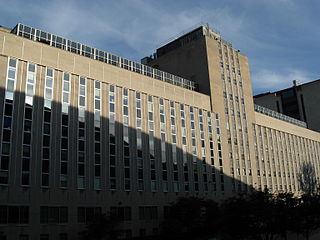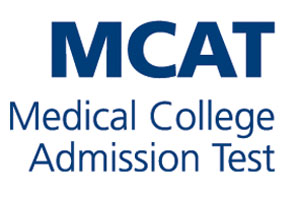The Association of American Medical Colleges (AAMC) is a nonprofit organization based in Washington, D.C. that was established in 1876. It represents medical schools, teaching hospitals, and academic and scientific societies, while providing services to its member institutions that include data from medical, education, and health studies, as well as consulting. The AAMC administers the Medical College Admission Test and operates the American Medical College Application Service and the Electronic Residency Application Service. Along with the American Medical Association (AMA), the AAMC co-sponsors the Liaison Committee on Medical Education (LCME), the accrediting body for all U.S. MD-granting medical education programs.
The Medical Scientist Training Programs (MSTPs) are dual-degree training programs that streamline the education towards both clinical and research doctoral degrees. MSTPs are offered by some United States medical schools, who are awarded financial support from the National Institute of General Medical Sciences, a branch of the National Institutes of Health (NIH). The goal of these training programs is to produce physician scientists who can translate laboratory discoveries into effective treatments for patients.
Pre-medical is an educational track that undergraduate students mostly in the United States pursue prior to becoming medical students. It involves activities that prepare a student for medical school, such as pre-med coursework, volunteer activities, clinical experience, research, and the application process. Some pre-med programs providing broad preparation are referred to as “pre-professional” and may simultaneously prepare students for entry into a variety of first professional degree or graduate school programs that require similar prerequisites.

The University of Pittsburgh School of Medicine is a medical school of the University of Pittsburgh, located in Pittsburgh, Pennsylvania. The School of Medicine, also known as Pitt Med, encompasses both a medical program, offering the doctor of medicine, and graduate programs, offering doctor of philosophy and master's degrees in several areas of biomedical science, clinical research, medical education, and medical informatics.
The Liaison Committee on Medical Education (LCME) is an accrediting body for educational programs at schools of medicine in the United States and Canada. The LCME is sponsored by the Association of American Medical Colleges and the American Medical Association.
The American Medical College Application Service (AMCAS) is a service run by the Association of American Medical Colleges through which prospective medical students can apply to various medical schools in the United States. It thus acts as something of a Common Application among the schools.
Medical school in the United States is a graduate program with the purpose of educating physicians in the undifferentiated field of medicine. Such schools provide a major part of the medical education in the United States. Most medical schools in the US confer upon graduates a Doctor of Medicine (MD) degree, while some confer a Doctor of Osteopathic Medicine (DO) degree. Most schools follow a similar pattern of education, with two years of classroom and laboratory based education, followed by two years of clinical rotations in a teaching hospital where students see patients in a variety of specialties. After completion, graduates must complete a residency before becoming licensed to practice medicine.
Most physicians in the United States hold either the Doctor of Medicine degree (MD) or the Doctor of Osteopathic Medicine degree (DO). Institutions awarding the MD are accredited by the Liaison Committee on Medical Education (LCME). Institutions awarding the DO are accredited by the Commission on Osteopathic College Accreditation (COCA). The World Directory of Medical Schools lists both LCME accredited MD programs and COCA accredited DO programs as US medical schools. Foreign-trained osteopaths do not hold DO degrees and are not recognized as physicians in the United States or in other jurisdictions.
The American Medical Association (AMA) Physician Masterfile includes current and historical data on all physicians, including AMA members and nonmembers, and graduates of foreign medical schools who reside in the United States and who have met the educational and credentialing requirements necessary for recognition as physicians. A Masterfile record is created and ME number assigned when entering medical school or through the ECFMG. For medical students, there are two primary methods to create the initial record - the Student Outreach Program and the annual freshman matriculation file received from the Association of American Medical Colleges (AAMC).
Doctor of Osteopathic Medicine is a medical degree conferred by the 38 osteopathic medical schools in the United States. DO and Doctor of Medicine (MD) degrees are equivalent: a DO graduate may become licensed as a physician or surgeon and thus have full medical and surgical practicing rights in all 50 US states. As of 2021, there were 168,701 osteopathic physicians and medical students in DO programs across the United States. Osteopathic medicine emerged historically from the quasi-medical practice of osteopathy, but has become a distinct and proper medical profession.

The University of Central Florida College of Medicine is an academic college of the University of Central Florida located in Orlando, Florida, United States. The VP of Health Affairs and dean of the college is Deborah German.
Geisinger Commonwealth School of Medicine (GCSOM) is a private medical school associated with the Geisinger Health System in northeastern and north central Pennsylvania. GCSOM offers a community-based model of medical education with six regional campuses - North, South, Central, West, Atlanticare, and Guthrie. It offers a Doctor of Medicine (MD) Program and a Master of Biomedical Sciences (MBS) Program.

The George Washington University School of Medicine and Health Sciences is the professional medical school of the George Washington University, in Washington, D.C. SMHS is one of the most selective medical schools in the United States based on the number of applicants.

The University of California, Riverside (UCR), School of Medicine is the graduate medical school of the University of California, Riverside, acting as one of six University of California medical schools. It enrolled its first class in 2013, with the first class of 40 medical students receiving their degrees on June 9, 2017.

The Medical College Admission Test is a computer-based standardized examination for prospective medical students in the United States, Australia, Canada, and the Caribbean Islands. It is designed to assess problem solving, critical thinking, written analysis and knowledge of scientific concepts and principles. Before 2007, the exam was a paper-and-pencil test; since 2007, all administrations of the exam have been computer-based.

The Frank H. Netter M.D. School of Medicine at Quinnipiac University, also known colloquially as Quinnipiac Medical School, or simply "Netter," is a medical school located in North Haven, Connecticut. The medical school was established in 2010 with its first class starting in 2013.

University at Buffalo School of Medicine and Biomedical Sciences, also known as Jacobs School of Medicine and Biomedical Sciences, is a public medical school in the city of Buffalo, New York, at the University at Buffalo. Founded in 1846, it is one of the oldest medical schools in the United States and is the only medical school in Buffalo. It is part of the State University of New York (SUNY) system.

The City University of New York (CUNY) School of Medicine is a public medical school that was established on June 10, 2015, and began operation in the fall of 2016. The school is in Hamilton Heights on the campus of The City College of New York (CCNY) and partners with Saint Barnabas Health System in the South Bronx, Harlem Hospital Center of NYC Health + Hospitals Corporation, and Staten Island University Hospital of Northwell Health for clinical medical education.

California Northstate University College of Medicine is a private medical school located in Elk Grove, California, granting the degree of Doctor of Medicine (MD). It is one of the seven colleges of California Northstate University. The other colleges are College of Pharmacy, College of Dental Medicine (DMD), College of Health Sciences, College of Psychology, College of Graduate Studies, and College of Nursing.








